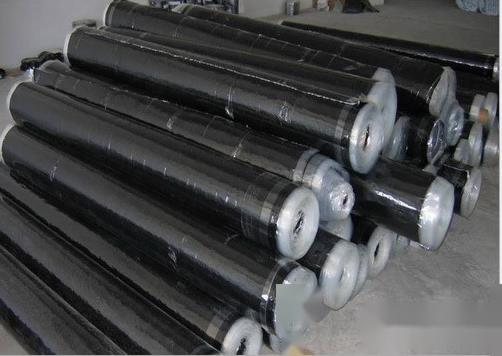1. Product Introduction
HNP-104 wet-laid self-adhesive polymer modified asphalt waterproofing membrane is made of polyester fiber non-woven fabric as the base, coated with self-adhesive modified asphalt on both sides, with a polyethylene film, fine sand, and other isolation materials on the bottom surface, and coated with silicone isolation membrane or silicone release paper on the top surface as isolation materials. It is suitable for self-adhesive waterproofing membranes using the pre-laid reverse bonding construction method. The standard is: GB/T 23457-2009 “Pre-laid/Wet-laid Waterproof Membrane”.
 2. Classification and Specifications
2. Classification and Specifications
Classification: According to the top surface materials, there are three types: polyethylene film (PE), fine sand (S), and non-film.
According to the bonding surface, there are two types: single-sided adhesive (S) and double-sided adhesive (D).
3. Product Features
1. The polyester substrate has high tensile strength, large elongation, strong nail tear resistance, and is highly adaptable to the expansion and contraction and cracking deformation of the substrate;
2. Good bonding performance, the seams of the membrane bond with the lifespan of the membrane, ensuring safety and environmental protection;
3. Fully bonded with the building structure, effectively preventing liquid water and water vapor from entering the structure;
4. After the wet-laid membrane construction, steel bars and concrete can be laid directly without a protective layer, accelerating the construction progress.
4. Scope of Application
1. Suitable for waterproofing of base slabs and side walls in underground projects such as building basements and open-cut subways;
2. Can also be used for waterproofing projects on roofs and other areas using the pre-laid reverse bonding construction method.
5. Construction Method
a. Pre-laid waterproofing membrane
2. The base surface should be dry, clean, and free of standing water.
3. Remove dust and debris, and repair and level local defects.
4. Apply a dedicated base treatment agent, ensuring even application without exposing the base or accumulating.
5. Place the self-adhesive layer of the membrane facing the structure, with the PE film side down, pre-laid on the concrete cushion, base slab cushion, and maintenance structure of the underground project.
6. The membrane should be laid flat and straight, with accurate overlap dimensions, and as much air as possible should be removed from underneath the membrane, using a dedicated roller to press and compact.
7. At the seams of two adjacent membranes, use the overlapping method, tearing off the reserved isolation strip on the adhesive edge and directly adhering it to form a sealed waterproof system.
8. Remove the release paper, and directly tie the steel bars without the need to pour mortar or concrete protective layers on the pre-laid membrane. The self-adhesive membrane will tightly adhere to the concrete structural body, achieving full bonding.
b. Wet-laid waterproofing membrane
Before waterproofing construction, remove and clean up protrusions on the base surface.
1. Fully moisten the base surface in advance, then spread cement slurry. If the evenness of the base is poor, cement mortar can be used; during dry-laid construction, the base treatment agent can be applied directly on the dry base before laying.
2. Cut the membrane and remove the release film from the bottom surface of the membrane.
3. Roll the membrane onto the cement mortar.
4. Remove air from beneath the membrane, while firmly adhering the overlapping edges of adjacent membranes.













